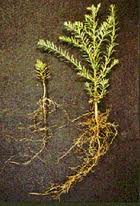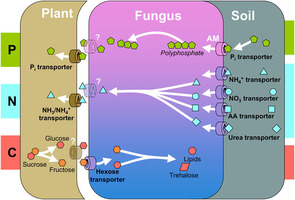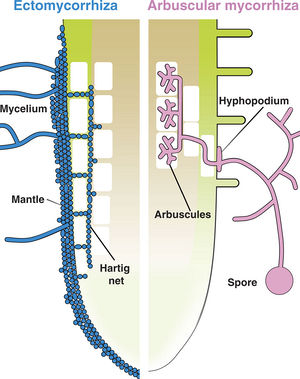Mycorrhizae: Difference between revisions
No edit summary |
|||
| Line 31: | Line 31: | ||
On the other hand, if an area contains large amounts of nitrogen, phosphorus, or water, it is not likely that a plant will allocate its carbon to its roots and therefore it is not likely that a symbiotic relationship with mycorrhizae will occur ([http://treephys.oxfordjournals.org/content/30/7/807.full 4]). This is because the benefit to the fungus would be greater than that for the plant. Since the plant already has enough availability to nutrients and water, there would be no reason for them to give up their carbon for this relationship. | On the other hand, if an area contains large amounts of nitrogen, phosphorus, or water, it is not likely that a plant will allocate its carbon to its roots and therefore it is not likely that a symbiotic relationship with mycorrhizae will occur ([http://treephys.oxfordjournals.org/content/30/7/807.full 4]). This is because the benefit to the fungus would be greater than that for the plant. Since the plant already has enough availability to nutrients and water, there would be no reason for them to give up their carbon for this relationship. | ||
== | ==Types of Mycorrhizal Associations== | ||
[[Image:mycorrhizae.jpg|thumb|300px|right|This picture compares the structures of endomycorrhizae (left) to arbuscular mycorrhizae (right) ([http://www.nature.com/ncomms/journal/v1/n4/full/ncomms1046.html 3]).]] | [[Image:mycorrhizae.jpg|thumb|300px|right|This picture compares the structures of endomycorrhizae (left) to arbuscular mycorrhizae (right) ([http://www.nature.com/ncomms/journal/v1/n4/full/ncomms1046.html 3]).]] | ||
Latest revision as of 15:45, 21 February 2012
Introduction

Mycorrhizae can be described as a symbiotic relationship between a fungus and a plant (7). Due to the fact that this is a symbiotic relationship, both the fungus and the plant benefit from this interaction. Since the plants are aboveground, it is often easier to see the benefits of this association for the plant, but the fungus also takes advantage of this partnership. The mycorrhizae aid the plant with growth, yield, improved fitness, increase the root absorption area of nutrients, while the fungus receives carbon from the associated plant (7). This is an important interaction due to the benefits that the plants receive. Improved plant growth and yield can aid in the production of crops and therefore produce more plants per area. Although mycorrhizae produce the same overall effects, there are two main types of this fungus. Endomycorrhizae and ectomycorrhizae are the two main types of mycorrhizae that produce the same overall results, but with different fungal characteristics (1). Below, more will be explained about the interaction between the fungus and plant, the niches that they are able to occupy, descriptions of the types of mycorrhizae, and the microbial processes that occur.
Biological interaction

Mycorrhizae create a symbiotic relationship between a plant and a fungus where both organisms benefit from the interaction. Although both the plant and fungi benefit from the partnership, they benefit in different ways.
Benefits for Plants
Mycorrhizae are able to create a vast connection between the roots of a plant and with the soil around them, which allows for the fungus to uptake nutrients such as nitrogen and phosphorus for the plant and increase the surface area of the roots (7). With this increased surface area, it is obvious that the plant will have many benefits. This increase in area within the soil will increase the availability of nutrients and water for the plants consumption. Since nutrients and water are needed in order for plant growth, this mycorrhizal interaction can lead to an increase in the growth of the plant.
This increase in nutrient availability for the plant leads to even more advantages. A plant with a mycorrhizae interaction will be able to increase its nutrient and water uptake, while a plant without this partnership will just have to rely on its roots for the uptake of materials. If a plant with this symbiosis is in an area with plants who do not have a mycorrhizae partnership, the fungi and plant partnership can give the plant the ability to out compete other plants. Overall, this means that mycorrhizae interactions can lead to changes in the plant composition of an area.
Benefits for the Fungi
Since this is a symbiotic relationship, the fungus benefits from the partnership as well. While aiding plants in the uptake of nutrients and water, the plants will give ten to twenty percent of the carbon they obtain from [photosynthesis] to the fungus (1). Overall, this is a small price for the plant to pay given that the fungus is providing nutrients and water that will allow it to prosper in its given environment.
Niche
Overall, the relationship between plants and mycorrhizal fungi depend mainly on the availability of nitrogen, phosphorus, carbon, and water (1). Since areas within the environment vary in nutrient and water availability, this can have a major effect on whether or not a mycorrhizal relationship can form between a plant and the fungus.
Environment Suitable for Mycorrhizae
If an environment's soil does not contain much nitrogen and phosphorus, it is likely that a mycorrhizal relationship will occur and a plant is more likely to allocate its carbon to the roots (4). This is because the plant needs nitrogen and phosphorus in order to prosper. This can also be true in areas where water is not easily accessible. As noted earlier, mycorrhizae expand the surface area of roots and therefore aid in the uptake of water. If an environment is lacking in moisture available to plants, it is likely that a mycorrhizal symbiosis will occur to aid in the uptake of water. Also, the environment where mycorrhizae will be found change depending on the type of mycorrhizae.
Environment not Suitable for Mycorrhizae
On the other hand, if an area contains large amounts of nitrogen, phosphorus, or water, it is not likely that a plant will allocate its carbon to its roots and therefore it is not likely that a symbiotic relationship with mycorrhizae will occur (4). This is because the benefit to the fungus would be greater than that for the plant. Since the plant already has enough availability to nutrients and water, there would be no reason for them to give up their carbon for this relationship.
Types of Mycorrhizal Associations

Endomycorrhizae
This type of mycorrhizae differs in its structure from the ectomycorrhizae. The endomycorrhizae grows in between the cells of a plant root but also forms arbuscules, which are structures that allow the fungus to penetrate the actual cells in the plant root (3). This type of mycorrhizae is more invasive than that of the ectomycorrhizae.
Arbuscular Mycorrhizae
Arbuscular mycorrhizae belong to the phylum Glomeromycota and are the most widespread of the mycorrhizae species (3) Since arbuscular mycorrhizae are the most common, they are also the most well-known and studied. This type of fungi also has a very high affinity for phosphorus (3). This natural attraction of phosphorus has lead to its ability to become widespread and very common.
Ericaceous Mycorrhizae
Ericaceous mycorrhizae are a type of endomycorrhizae that penetrate the root cells without creating arbuscules and this relationship is found on vegetation within the order of Ericales (7).
Orchidaceous Mycorrhizae
This is another type of endomycorrhizae association, but is needed to supply carbon and other nutrients to plants within the Orchidaceae order by penetrating the root cells and creating hyphal coils (7).
Ectomycorrhizae
Ectomycorrhizae mainly interact with forest tree species such as Pinaceae and Fagaceae and are species of Basidiomycetes and Ascomycetes (3). Ectomycorrhizae also differ from endomycorrhizae in their structure. Ectomycorrhizae produce a system of hyphae, called the hartig net, in between the cells in the root of a plant (7).The mycorrhizae is within the plant root, but does not enter the actual cells of the roots and instead travels between the root cells. This fungus also forms a mantle around the outside of the roots of plants and increases the surface area of the roots and acts as a shield against pathogens (7). With this sheath, the endomycorrhizae are able to increase the plant's ability to obtain nutrients and water.
Functions of Mycorrhizae
This relationship between the fungus and a plant can obviously have a great impact on the environment. In areas where drought is prevalent, the plants that are able to use mychorrhizae to increase root surface area and obtain water will have an advantage over those without this symbiotic relationship. The same can be said about environments that are low in nutrients such as nitrogen and phosphorus. The plants that can have this association with mycorrhizal fungi will have a greater chance in inhabiting this area.
Nutrient Acquisition
The major function of mycorrhizae is their ability to exchange nutrients between their surroundings and their host plant. With the increase in root surface area and the protection they offer to the plant's roots, the fungus is able to acquire a lot of nutrients for its host. Mycorrhizae are able to uptake water, inorganic phosphorus, mineral or organic nitrogen, and amino acids through specialized transporters located on their membrane (3). Once the water and nutrients are acquired, they can then be transferred to the host, who in return supplies carbon.
Aiding in Agriculture
Since mycorrhizal relationships can help to increase plant growth and therefore yield, they can be beneficial in agricultural fields. An increase in yield for farmers also means an increase in income. This symbiotic relationship in agricultural fields would increase crop production and therefore increase food output.
The mycorrhizal fungi also aids in soil aggregation, which can increase water filtration and gas exchange within the soil (7). With an increase in gas exchange, the mycorrhizal fungi can aid in the aeration of agricultural fields. This, along with the other benefits of mycorrhizae, can increase the crop yield.
Aiding in Restoration
This symbiotic relationship can also be helpful in restoration areas. Since the fungus allows certain plants to be greater competitors and can allow them to prosper in areas low in nutrients and water, they would be very useful in restoration efforts. Not only could this partnership increase a plant's ability to colonize an area, they would also have a greater capacity to out compete [invasive species].
Current Research
Since mycorrhizae can form beneficial relationships with plants, many experiments have been performed to research the extent of these advantages.
"Influence of Arbuscular Mycorrhizae on the Root System of Maize Plants under Salt Stress"
This experiment aimed at discovering the effect of salinity on corn with mycorrhizal relationships. The effect of salinity was tested because of its ability to reduce growth and yield of crops. On the other hand, arbuscular mycorrhizae (endomycorrhizae) is known for its ability to increase the growth and yields of plants. In order to conduct this experiment, corn was planted in soil with five different salinity levels for a total of fifty-five days. Half the corn in each different salinity level had a mycorrhizal partnership while the other half of the corn did not. After the days were up, the plants were then removed and their root biomass, root morphology, and root activity. The compiled data showed that the corn associated with the arbuscular mycorrhizae had a larger root biomass, root morphology, and root activity in all of the salinity levels compared with the corn without the symbiotic association. All in all, this research showed that the corn with the arbuscular mycorrhizae was able to alleviate some of the stress caused by high salinity levels.
"Contribution of Mycorrhizae to Early Growth and Phosphorus Uptake by a Neotropical Palm"
In this experiment, the association between Desmoncus orthacanthos and arbuscular mycorrhizae was tested. Desmoncus orthacanthos is known for its large roots that do not branch and do not have many hairs. Due to this, research was done to test the ability of the mycorrhizae to increase phosphorus uptake and to increase the growth of the plant seedlings. Seedlings were planted in soil with three different levels of phosphorus for a total of one hundred and sixty days. Half of the seedlings had a partnership with the arbuscular mycorrhizae while the other half did not have an association with this fungus. After the experiment was over, the growth of each seedling was measured. Overall, the concentration of phosphorus in the seedlings increased with the mycorrhizae association as well as with the increased phosphorus in the soil. This experiment revealed that it is very beneficial for Desmoncus orthacanthos seedlings to have a partnership with arbuscular mycorrhizae especially when they are in soil with low levels of phosphorus.
"Arbuscular Mycorrhizae Improves Low Temperature Stress in Maize via Alterations in Host Water Status and Photosynthesis"
This experiment tested the effect of low temperatures on the growth of corn. Low temperatures are an abiotic factor that can greatly reduce and limit the growth of plants. With this said, this experiment tested the ability of arbuscular mycorrhizae on the water uptake, growth, and chlorophyll concentration in corn. In order to carry out this research, corn with and without arbuscular mycorrhizae associations were planted in soil for seven weeks in a temperature of twenty-five degrees Celsius. Next, the plants were introduced to temperatures of five degrees Celsius, fifteen degrees Celsius, and twenty-five degrees Celsius for a week. After the results were compiled, it was shown that as the temperature decreased, so did the concentration of arbuscular mycorrhizae on the roots of the corn that had this symbiotic relationship. Although the concentration of the fungi did decrease with temperature, the corn with the mycorrhizal association showed a higher plant growth, dry root weight, water uptake, chlorophyll concentration, and photosynthesis rate than the corn without this partnership. Overall, this experiment came to the conclusion that with arbuscular mycorrhizae, corn has the ability to improving its water uptake and photosynthesis rate when exposed to low temperatures.
References
(1) Allen, M, W. Swenson, J.I. Querejeta, L.M. Egerton-Warburton, and K.K. Treseder. "Ecology of Mycorrhizae: A Conceptual Framework for Complex Interactions Among Plants and Fungi." Phytopathology 41 (Sept. 2003): 271-300. Annual Reviews. Web. 28 March 2011.
(2) Amaranthus, Mike. "Mycorrhizal Fungi Benefits." Heart Spring. N.p., 11 Jan. 2011. Web. 5 Apr. 2011.
(3) Bonfante, Paola, and Andrea Genre. "Mechanisms underlying beneficial plant-fungus interactions in mycorrhizal symbiosis." Nature Communications 48 (2010).
(4) Kleczewski, Nathan M, Daniel Herms, and Pierluigi Bonello. "Effects of soil type, fertilization and drought on carbon allocation to root growth and partitioning between secondary
metabolism and ectomycorrhizae of Betula papyrifera." Tree Physiology, July 2010, Vol. 30 Issue 7, 807-817.
(5) Ramos-Zapata, Jose, Roger Orellana, Patricia Guadarrama, and Salvador Medina-Peralta. "Contribution of Mycorrhizae to Early Growth and Phosphorus Uptake by a Neotropical Palm". Journal of Plant Nutrition, May
2009, Vol. 32 Issue 5, 855-866.
(6) Sheng, Min, Ming Tang, Hui Chen, Baowei Yang, Fengfeng Zhang, and Yanhui Huang. "Influence of arbuscular mycorrhizae on the root system of maize plants under salt stress". Canadian Journal of Microbiology,
Jul2009, Vol. 55 Issue 7, p879-886.
(7) Sylvia, David, Jeffry Fuhrmann, Peter Hartel, and David Zuberer. Principles and Applications of Soil Microbiology. Upper Saddle River, NJ: Pearson, 2005.
(8) Xian-Can, Zhu, Song Feng-Bin, and Xu Hong-Wen."Arbuscular mycorrhizae improves low temperature stress in maize via alterations in host water status and photosynthesis". Plant
& Soil, Jun2010, Vol. 331 Issue 1-2, p129-137.
Edited by Lisa Reger, a student of Angela Kent at the University of Illinois at Urbana-Champaign.
